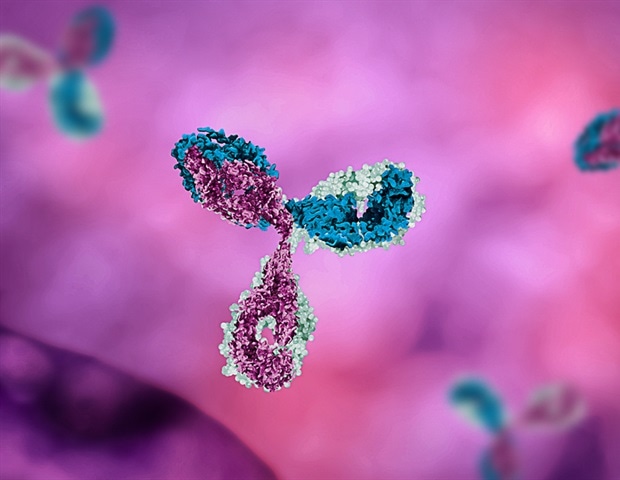Researchers found that Akkermansia muciniphila boosts lung-specific antiviral immunity against SARS-CoV-2 in mice by modulating the gut–lung axis....
Vous n'êtes pas connecté
Rubriques :
 - RAWSTORY.COM - Raw Story - 09/09/2024 15:26
- RAWSTORY.COM - Raw Story - 09/09/2024 15:26
Long COVID inflicts deep scars on the lungs, targeting specific cells could reverse damage
The long-term effects of respiratory viral infections such as COVID-19 are a major public health burden. Some estimates suggest over 65 million people around the world suffer from long COVID-19. Efforts to better understand this condition, however, have been hampered by its ability to affect multiple organ systems, such as those involving the lungs, brain and heart. This is further complicated by the lack of animal models that can sufficiently mimic the disease. Animal models, such as mice and rats, are a crucial tool that researchers use to study human diseases and develop treatment strategies. Although there are major differences between humans and animal models, the vast majority of our immune and organs systems function similarly. Such similarities in physiology have made significant health care discoveries, including those related to COVID-19, possible. I am an immunology researcher in the Sun Lab at the University of Virginia. We study the role the immune system plays in respiratory viral infections such as influenza and COVID-19. In our newly published research, we developed a new mouse model to study long COVID-19 and found that blocking certain overactive immune cells can restore lung function.New models, new targetsOut team wanted to better understand the long-term effects of COVID-19 on the respiratory system. To do this, we worked to identify key features associated with lung scarring following COVID-19. First, we examined lung samples from patients with long COVID-19. Although these patients were infected several months to years before the samples were taken, we found evidence of an overactive immune system in their lungs, particularly within areas that failed to fully repair themselves after infection. Next, we aimed to create a mouse model for long COVID-19 by comparing the pathology of mice infected with four different types of respiratory viral infections. Surprisingly, we found that mice infected with influenza virus, rather than the COVID-19 mouse models scientists currently use, best replicated the physical features of severe chronic lung disease. The reasons why infections from different respiratory viruses affect the lungs in different ways are unclear. But preliminary evidence suggests it may be because each virus targets different types of cells in humans and mice. Additionally, since long COVID-19 is about the damage left behind after infection, it seems less important what virus causes the problem in our animal model than that the damage is similar to what we want to address in human patients. Long COVID-19 can be debilitating.Using our new mouse model, we were able to identify the presence of an abnormal cluster of cells in mice lungs – made up of the same dysfunctional immune and epithelial, or structural, cells seen in the lungs of long-COVID-19 patients. Additionally, we found that the uncontrolled activity of these immune cells in the lungs impeded structural cells from repairing themselves. It also hindered them from restoring gas exchange, the process of taking in oxygen and releasing carbon dioxide. Importantly, when we blocked the activity of proteins associated with this overactive immune response, it reduced lung scarring and restored optimal lung function in mice. Treating respiratory viral infectionsMost approaches to addressing long COVID-19 rely on starting treatment early after infection. To the best of our knowledge, our study is the first to identify strategies to treat the respiratory symptoms of long COVID-19 after this chronic disease develops.The drugs we tested in our study have already been approved by the Food and Drug Administration to treat severe COVID-19 and other inflammatory conditions. We hope our findings can spur further research on using these drugs to treat long COVID-19. Our work may have applications beyond long COVID-19. Growing evidence suggests that many respiratory viral infections, such as influenza, COVID-19 and respiratory syncytial virus, may result in chronic lung disease. Considering the four pandemics and even more respiratory viral epidemics that have occurred in the past 100 years, studying the cellular and molecular similarities between respiratory viral infections may be critical to how medical practitioners respond to future viral outbreaks.Harish Narasimhan, Ph.D. Candidate in Immunology, University of VirginiaThis article is republished from The Conversation under a Creative Commons license. Read the original article.
Articles similaires
Engineered protein silences harmful T cells in autoimmune disease
An engineered protein turns off the kind of immune cells most likely to damage tissue as part of Type-1 diabetes, hepatitis, multiple sclerosis, shows...
I’m an expert in vaccine safety. Here's what RFK Jr. doesn't get
href="https://theconversation.com/profiles/jake-scott-2417752">Jake Scott, Stanford UniversityIn the four months since he began serving as secretary...
I’m an expert in vaccine safety. Here's what RFK Jr. doesn't get
href="https://theconversation.com/profiles/jake-scott-2417752">Jake Scott, Stanford UniversityIn the four months since he began serving as secretary...
Breathe Easier with Better Nutrition – Eating to Fight Respiratory Infections
The arrival of the rains and relatively cold weather often signals the start of flu season, bringing with it a rise in coughs, cold, and other...
Breathe Easier with Better Nutrition – Eating to Fight Respiratory Infections
The arrival of the rains and relatively cold weather often signals the start of flu season, bringing with it a rise in coughs, cold, and other...
'Razor Blade throat in Covid 19:' Why does it hurt so much
COVID-19 is essentially a respiratory infection that infects the body through the nose, mouth, and throat, which are part of the upper respiratory...
'Razor Blade throat in Covid 19:' Why does it hurt so much
COVID-19 is essentially a respiratory infection that infects the body through the nose, mouth, and throat, which are part of the upper respiratory...
Did Covid Vaccines Really Save Millions? – OpEd
This article was co-authored by Yaffa Shir-Raz, Shay Zakov, and Peter A. McCullough. Two years have passed since the official end of the Covid-19...
Finding Suggests Treatment Approach for Autoimmune Diseases
NEW YORK, June 30, 2025 /PRNewswire/ -- An engineered protein turns off the kind of immune cells most likely to damage tissue as part of Type-1...
Les derniers communiqués
-
Amazon’s Biggest Prime Day Event Yet: An Extended 4 Days of Exceptional Savings and Deep Discounts from Top Brands
AMAZON - 30/06/2025
-
DHS Awards $94 Million in Grants to Help Protect 512 Jewish Faith-Based Organizations from Targeted Violence and Terrorism
The Department of homeland security - 27/06/2025
-
FACT CHECK: ICE Provided Full Medical Care to Guatemalan Illegal Alien with History of Child Abuse and Wanted for Homicide
The Department of homeland security - 26/06/2025
-
Secretary Noem Terminates Wasteful DHS Program that Encouraged DEI in K-12 Schools
The Department of homeland security - 26/06/2025
-
Top EHR-Native Patient Accounting Systems Named by Black Book Research: Epic Resolute, MEDITECH, and TruBridge Lead Across Hospital Segments
Black Book Research - 26/06/2025
-
TECO Unveils New Website Highlighting Custom Flow and Analytical Solutions and Industrial Instrumentation
Thompson Equipment Company - 26/06/2025
-
Worldwide Banners Launches Australian Platform, Offering Direct Investment in Brand Advertising Campaigns as an Alternative Asset Class
Worldwide Banners - 26/06/2025
-
Mental Health America of Central Carolinas Launches Inaugural Southeast Regional Conference on Mental Health
Mental Health America of Central Carolinas - 26/06/2025
-
AVTECH's Room Alert MAX Product Family Wins Prestigious 2025 MSP Today Product of the Year Award
AVTECH Software, Inc - 26/06/2025
-
TauOne Unveils Hardware-Agnostic AGI Platform Powered by Quantum Symbolic Logic - Outperforming AI + QC Industry Roadmaps by Years
TauOne LLC - 26/06/2025





